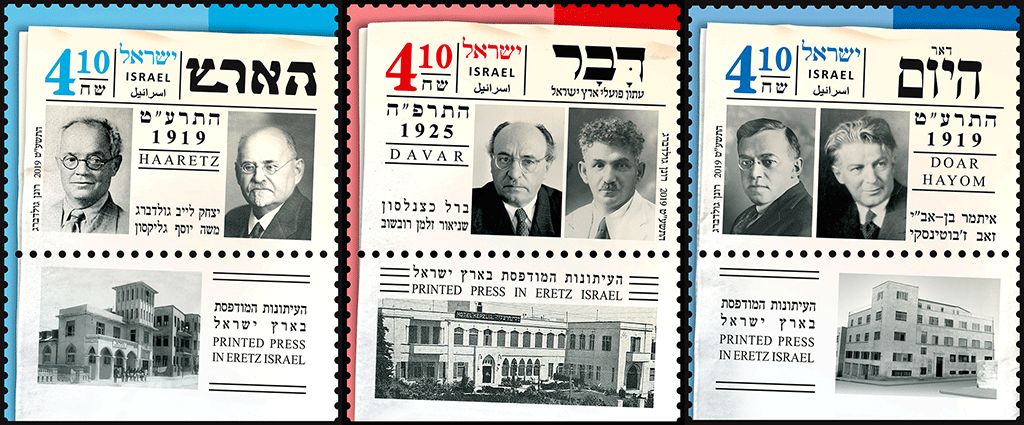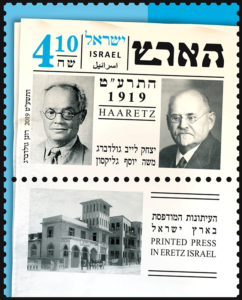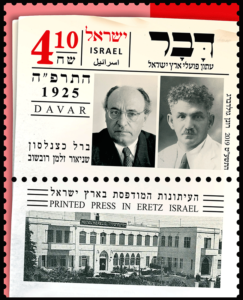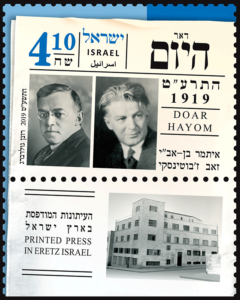Three stamps: Haaretz, Davar, Doar Hayom
Date of Issue: 01 May 2019
Size of stamps: W: 40 mm H: 30 mm
Face Value: NIS 4.10, 4.10,4.10
Plate Block No. 1116, 1117, 1118
Designer: Ronen Goldberg
Printing Method: Offset
Printer: Cartor Security Printing, France
Sheet Type: Regular
Stamps per sheet: 15
Tabs: 5
No. of FDC’s: 1
Price of FDC’s: NIS 13.50
Place of cancellation: Jerusalem
From Israel Post:
The printed press has existed in Eretz Israel since 1863, mostly in Hebrew, along with some other languages as well. The first daily newspaper was published in 1908, but a wider range of daily newspapers did not appear until after WWI. In the summer of 1919, two dailies appeared within weeks of each other: News of Haaretz (which changed its name after a few months to Haaretz) and Doar Hayom.
Haaretz, 1919
 News of Haaretz was the civilian version of the British military weekly in Hebrew The Palestine News which was published for just one year (April 1918 – April 1919). When the British put it up for sale the Zionist Organization could not fund the purchase and called upon Isaac Leib Goldberg, a wealthy man and passionate Zionist from Eastern Europe, who acquired the newspaper and served as its first publisher.
News of Haaretz was the civilian version of the British military weekly in Hebrew The Palestine News which was published for just one year (April 1918 – April 1919). When the British put it up for sale the Zionist Organization could not fund the purchase and called upon Isaac Leib Goldberg, a wealthy man and passionate Zionist from Eastern Europe, who acquired the newspaper and served as its first publisher.
Goldberg retired from Haaretz after only a few years, but continued to support it financially and otherwise until his death in 1935.
The newspaper had significant financial troubles due to limited circulation and a lack of advertising, as the Jewish population numbered no more than 60,000. It had three different editors within three years: Nissan Turov, Shmuel Perlman and Leib Yaffe. The newspaper’s financial crisis led Haaretz to close in late 1922. It later reopened under editor Moshe Yosef Glikson, who served in this position for 15 years, until the newspaper was acquired by the Schocken family.
In 1923, Haaretz moved from Jerusalem to Tel Aviv, where it has remained ever since.
Davar, 1925
The third newspaper, Davar, was first published in the summer of 1925. It was the journal of the Histadrut Workers Organization, which was a rising organization at that time, led by  David Ben Gurion. The decision to publish a daily newspaper was made at the Histadrut’s founding convention in 1920, but its implementation was delayed by internal struggles within the organization. Berl Katznelson, the ideologist of the Labor Movement in Eretz Israel, founded Davar and served as its first editor. Shneur Zalman Rubashov (Shazar), later the third President of Israel, was his head assistant. Shazar succeeded Katznelson as the newspaper’s editor upon his death in 1944.
David Ben Gurion. The decision to publish a daily newspaper was made at the Histadrut’s founding convention in 1920, but its implementation was delayed by internal struggles within the organization. Berl Katznelson, the ideologist of the Labor Movement in Eretz Israel, founded Davar and served as its first editor. Shneur Zalman Rubashov (Shazar), later the third President of Israel, was his head assistant. Shazar succeeded Katznelson as the newspaper’s editor upon his death in 1944.
Davar, as opposed to the other newspapers, established an “empire” of publications that included the punctuated daily Hege (that was later called Omer) as well as weekly, biweekly and monthly publications such as Davar for Children, Davar for Women Workers, Davar for the New Immigrant, Hameshek Hashitufi, a magazine in Arabic called Hakikat Al-Amar (The Word of Truth), as well as newspapers in English and German and an annual literary publication. Davar for Children was considered to be the leading children’s newspaper in Israel for more than 50 years.
Davar was the most popular and influential newspaper in Israel for many years. It was published in Tel Aviv for 71 years, until its closure in 1996.
Doar Hayom, 1919
The founders of Doar Hayom, Eliezer Ben-Yehuda and his son Itamar Ben-Avi were initially among the first at Haaretz but after only a few weeks they left and started their own  newspaper. Editor Itamar Ben-Avi derived the name of the Jerusalem-based newspaper from London’s Daily Mail. The right-wing Doar Hayom represented the veteran members of the Jewish Yishuv in Eretz Israel, the Sephardim and the farmers as opposed to the mid-left wing Haaretz and tended to publish more “scoops”, amusing stories from around the world and personal attacks on the heads of the Zionist movement and the Yishuv. Ben-Avi loathed Haaretz and used to say mockingly: “Haaretz may be a decent newspaper – but it isn’t a newspaper; Doar Hayom may not be decent, but it is a newspaper”.
newspaper. Editor Itamar Ben-Avi derived the name of the Jerusalem-based newspaper from London’s Daily Mail. The right-wing Doar Hayom represented the veteran members of the Jewish Yishuv in Eretz Israel, the Sephardim and the farmers as opposed to the mid-left wing Haaretz and tended to publish more “scoops”, amusing stories from around the world and personal attacks on the heads of the Zionist movement and the Yishuv. Ben-Avi loathed Haaretz and used to say mockingly: “Haaretz may be a decent newspaper – but it isn’t a newspaper; Doar Hayom may not be decent, but it is a newspaper”.
In late 1928, when Doar Hayom was actually the most popular newspaper in Eretz Israel, Ben-Avi inexplicably transferred the editor’s position to Ze’ev Jabotinsky, who turned it into the journal of the young Revisionist Movement. Two years later, the newspaper returned to Ben-Avi, who served as its editor until he retired in 1933. The newspaper continued to exist sporadically until 1940.
Doar Hayom was mostly published in Jerusalem.
—Dr. Mordecai Naor
The Buildings on the Stamps
The three buildings featured on the stamps housed the three newspapers – Haaretz, Doar Hayom and Davar.
The first building to house Haaretz was built by I.L. Goldberg on Montefiore St. in Tel Aviv (as featured on the stamp). The newspaper later moved to Mazeh St., where it remained for decades. Doar Hayom was housed in an office building on Hasolel St. in the center of Jerusalem. Hasolel was the name of the publishing company that published the newspaper. Today it is called Havazelet St., named after the second newspaper to appear in Jerusalem, in 1863, (the first was Halevanon).
For many years, Davar was housed in the Histadrut Executive Committee building on Allenby St. in Tel Aviv (which appears on the stamp). In the late 1940’s the newspaper moved to its own building on Shenkin St.



